
Gentlemen, start your engines!
This review was first published in MOTOR magazine's August 2008 issue.
Instead of pushing a button, please insert the weighty, traditionally fashioned ignition key which is long enough to foul a tall lad’s right kneecap. Now twist it, prick your ears, and watch carefully the response when lightning strikes on the other side of the tinted rear windscreen.
The V10 does not simply fire and run. Instead, it explodes, gasps for air, kicks its initial idle speed to 1250rpm and back to 750, and rubs cold pistons against equally cold cylinder walls as the dry-sump lubrication struggles to distribute oil to the faraway corners of the complex kraftwerk. Five, six seconds of martial metallic music frightens the wits out of birds and babies who happen to be close to the epicentre of this emphatically mechanical powerplant.
 Then the worst is over. Shell’s best takes audible effect, the firing order remembers its correct 10-digit sequence, the intake apparatus finally clears its throat, and the exhaust starts to warm up to its vocal mission.
Then the worst is over. Shell’s best takes audible effect, the firing order remembers its correct 10-digit sequence, the intake apparatus finally clears its throat, and the exhaust starts to warm up to its vocal mission.
While the engine is beginning to come to terms with itself, the auxiliary equipment continues to chatter. The noisy oil pump whirs loudest, followed by the gurgling water pump and the nasal air-con compressor.
It’s all happening in the dark, volcanic display area behind the firewall where the cylinder heads boast a black crackle paint finish which looks even meaner than the bright red livery preferred by the other fast-car power brokers from the other side of Modena.
Yes, the new 5.2-litre V10 in Lamborghini’s updated Gallardo LP560-4 is quantifiably stronger, badder and wilder than the 5.0-litre version it replaces. A true rev junkie, it features a stratified direct-injection system, more efficient intake and exhaust manifolds, variable valve timing, reduced-friction pistons and lighter camshafts.
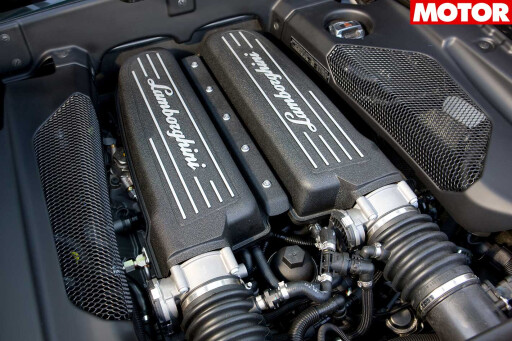 Up to 4500rpm, it hums along like the late Luciano Pavarotti on his way to work. Between 4500 and 6000rpm, it mimics the soundtrack of an earthquake. But from 6000rpm all the way to the 8300rpm redline, the steamhammer-on-steroids stuffs the eardrums with a dizzying array of multi-choral roars.
Up to 4500rpm, it hums along like the late Luciano Pavarotti on his way to work. Between 4500 and 6000rpm, it mimics the soundtrack of an earthquake. But from 6000rpm all the way to the 8300rpm redline, the steamhammer-on-steroids stuffs the eardrums with a dizzying array of multi-choral roars.
In Thrust Mode, it comes close to angering a Murcielago. The LP560-4 will accelerate from 0-100km/h in 3.7sec – that’s 0.3sec quicker than last year’s Superleggera and only 0.3sec slower than the mighty LP640. How does that compare to other supercars?
Well, the F430 Scuderia and the Mercedes-McLaren SLR are one-tenth faster still, and the 911 GT2 and the Pagani Zonda S are a dead heat, but none of these challengers can match the latest Lambo for aural thrills and mid-range vibes.
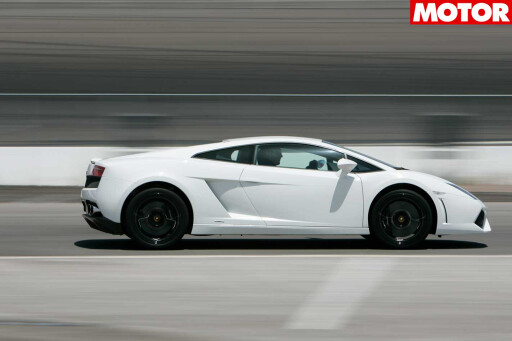 The low-inertia V10 loves max-power rev orgies, full-throttle upshifts and flat-out autostrada rides. It’s a true Supercortemaggiore addict (Italy’s famous high-power petrol developed by Agip in the ’50s), a raucous redline reamer. The bigger bore of 84.5mm, higher compression ratio of 12.5:1 and aforementioned modifications result in a 30kW increase to 412kW at 8000rpm, while max torque is up from 510 to 540Nm at a lofty 6500rpm.
The low-inertia V10 loves max-power rev orgies, full-throttle upshifts and flat-out autostrada rides. It’s a true Supercortemaggiore addict (Italy’s famous high-power petrol developed by Agip in the ’50s), a raucous redline reamer. The bigger bore of 84.5mm, higher compression ratio of 12.5:1 and aforementioned modifications result in a 30kW increase to 412kW at 8000rpm, while max torque is up from 510 to 540Nm at a lofty 6500rpm.
The E-gear equipped LP560-4 (which is a $16,000-odd premium over the manual gearbox) sprints to 200km/h in 11.8sec, beating its predecessor by half a second, and reaches 325km/h, up from 315. The six-speed manual is slower than the E-gear car, but equals the previous model’s performance.
A car as overtly aggressive as our Gallardo – even in snow white – does not really need a show-off button, but just to be safe, the LP560-4 has two.
One is labelled Corsa; the other one reads Sport. Sport loosens the ESP reins and speeds up the throttle response, while Corsa opens the door to the Thrust Mode program for which one could charge a fee from innocent bystanders.
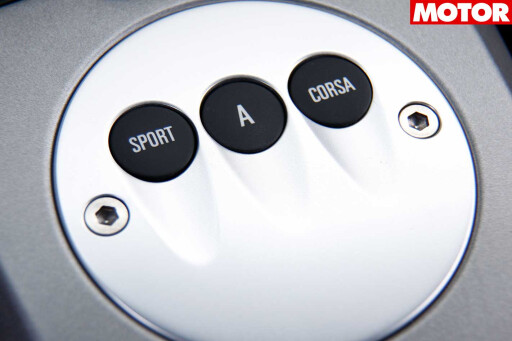 Push Corsa, switch off ESP, click-in first gear, keep the left foot on the brake and floor the loud pedal, causing the engine revs to flat-line at a steady 5000rpm. Then, lift the left hoof and brace yourself for things to come: a brief moment of tyre squeal, second gear before you can count to one and the faintest fishtail, corrected.
Push Corsa, switch off ESP, click-in first gear, keep the left foot on the brake and floor the loud pedal, causing the engine revs to flat-line at a steady 5000rpm. Then, lift the left hoof and brace yourself for things to come: a brief moment of tyre squeal, second gear before you can count to one and the faintest fishtail, corrected.
You’ll feel a mind-boggling kick in the butt as third gear is summoned, even at more than 160km/h, toward fourth.
Thanks to all-wheel drive, the traction, grip and stability are never at stake. It’s so simple to go 737-chasing in the LP560-4; it’s easy to waltz with grandezza round corners on wet tarmac and then to prescribe smokey arcs as it winds from mild understeer to mild oversteer.
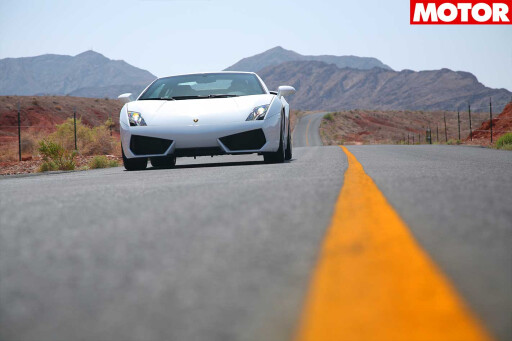 So what is the overriding first impression after a day in the latest crowd-stopper from Sant’Agata? The added punch of the engine?
So what is the overriding first impression after a day in the latest crowd-stopper from Sant’Agata? The added punch of the engine?
No. The more powerful engine is indeed a welcome asset, but it takes a hypersensitive bum loaded with g-force sensors to register the split-second advantages over the 2007 vintage. Instead, what makes all the difference is the better-connected steering, the more-compliant suspension, the less capricious E-gear transmission and the homogenous handling characteristics.
As far as the new steering is concerned, the stiffness and the substantial effort are history. Instead, it feels more progressive and fluent, almost as if there’s been a change in the fluid inside the steering rack from syrup to whisky.
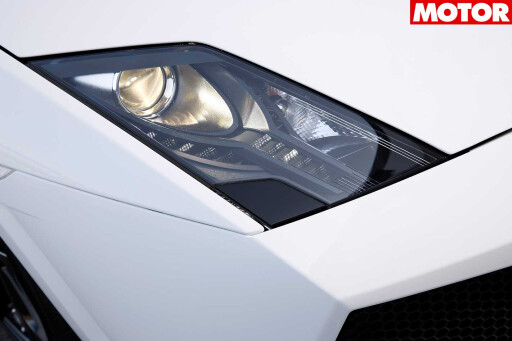 In addition, Lamborghini has developed a totally-revised double-wishbone front suspension, widened the front track by a smidgen and fitted quicker, more enthusiastically assisted rack-and-pinion gear. It’s almost as if the LP560-4 is the first bull that’s willing to prance.
In addition, Lamborghini has developed a totally-revised double-wishbone front suspension, widened the front track by a smidgen and fitted quicker, more enthusiastically assisted rack-and-pinion gear. It’s almost as if the LP560-4 is the first bull that’s willing to prance.
Also new is the double-wishbone rear axle complete with additional tie-rods, the overhead rear anti-roll bar and, most importantly, a larger rear subframe that accommodates the suspension-mounting points.
Together with the sticky dual-compound Pirelli P Zero LRR (low rolling resistance) tyres, this set-up takes away the edginess at the limit and somewhat softens the break-away behaviour so that lift-off oversteer is a vice of the past.
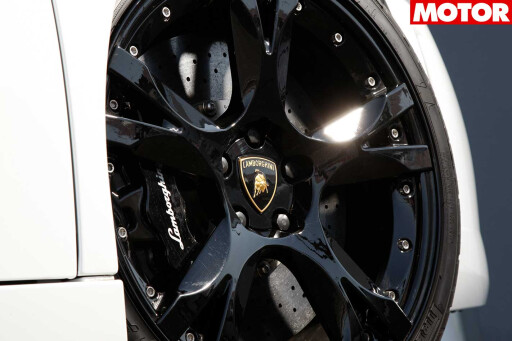 The LP560-4 not only provides more feedback in all key disciplines, the depth of information has also increased substantially.
The LP560-4 not only provides more feedback in all key disciplines, the depth of information has also increased substantially.
The customer can, for example, choose between steel and ceramic composite brakes, both offering improved cooling and heat dissipation. The latter option is larger in diameter yet lighter overall, but it needs higher temperatures to deliver the goods. Mainly thanks to some minor all-wheel-drive system upgrades, the kerb weight has dropped slightly from 1520 to 1500kg.
The new viscous coupling front diff splits the torque at a rate of 30 to 70 percent, but this ratio varies according to demand, so the typical give-it-all cornering attitude is push in, pull out. The downside of the freshened set-up is more turn-in understeer which can be a nuisance on cold tyres.
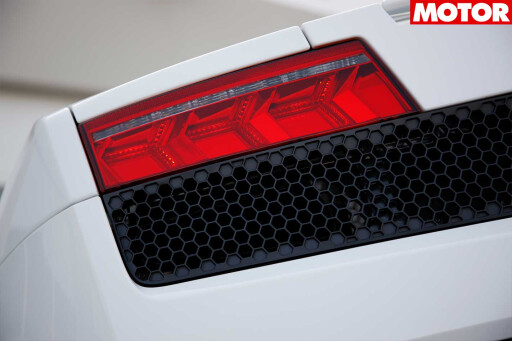 The E-gear ’box is governed by a better-educated control unit courtesy of Magneti Marelli. By pegging the shift timing on the speed of the input shaft rather than on a bunch of theoretical data, the Italian propellor-heads managed to increase shift speeds by 40 percent. Upshifts are as rapid as 110 milliseconds, which is Ferrari 599 territory.
The E-gear ’box is governed by a better-educated control unit courtesy of Magneti Marelli. By pegging the shift timing on the speed of the input shaft rather than on a bunch of theoretical data, the Italian propellor-heads managed to increase shift speeds by 40 percent. Upshifts are as rapid as 110 milliseconds, which is Ferrari 599 territory.
More relevant in real life is the actual shift quality (smooth instead of jerky), the shift action (instant and positive thanks to column-mounted paddles) and the totally relaxed operation in stop-and-go traffic (no hiccups, no delayed response, no over-eager downchanges).
Auto mode will get you from A to B, but it’s still a crude headbanger, no matter how delicate the throttle treatment may be. The Sport function provides the best compromise between harmony and velocity.
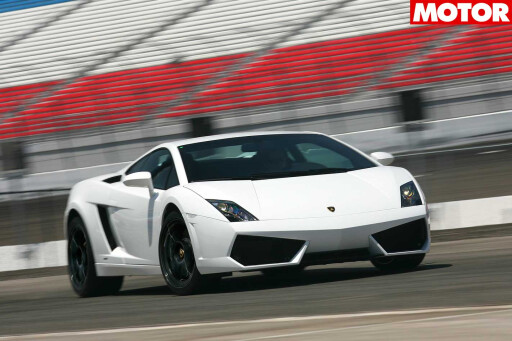 What it won’t do is alter the damper settings or the calibration of the springs because the LP560-4 relies on a fixed-spec set-up. But we may soon see a stiffer sports suspension, and the rumour mill is predicting a lightweight LP560-2 which would abandon all-wheel drive in favour of even more poise and panache.
What it won’t do is alter the damper settings or the calibration of the springs because the LP560-4 relies on a fixed-spec set-up. But we may soon see a stiffer sports suspension, and the rumour mill is predicting a lightweight LP560-2 which would abandon all-wheel drive in favour of even more poise and panache.
Design changes often cause arguments between marketing bods and engineering heads. But in this case, the two departments actually worked hand in hand.
The marketing mob wanted more presence and a closer proximity to the bad-arse Murcielago; the R&D lads wanted better cooling and superior aerodynamics. The car received both: the most aggressive front end in the supercar scene, and a more substantial throughput of air, together with 31 percent more downforce, especially in the rear where an automatic spoiler extends at 120km/h.
 While the 2008 Gallardo may not be quite as stoic beyond 200km/h as the LP640, it’s not really bothered by crosswinds and aquaplaning grooves. Subjectively at least, the slightly larger frontal area makes it a little more difficult to explore the upper echelon of its top speed in the 275-325km/h bracket.
While the 2008 Gallardo may not be quite as stoic beyond 200km/h as the LP640, it’s not really bothered by crosswinds and aquaplaning grooves. Subjectively at least, the slightly larger frontal area makes it a little more difficult to explore the upper echelon of its top speed in the 275-325km/h bracket.
High speeds require mega revs and a certain determination to keep up the momentum, which is why those ultra-fast autostrada sweepers call for dry palms and a certain amount of fatalism.
Inside, LP560-4 has detail changes like fresh instrument graphics, a row of chrome-capped switches, a relocated CD player, slightly less martial seats and a new steering wheel with a silly squared-off bottom; in vogue, as are the speedo and rev counter needles that swing round once as you start the engine.
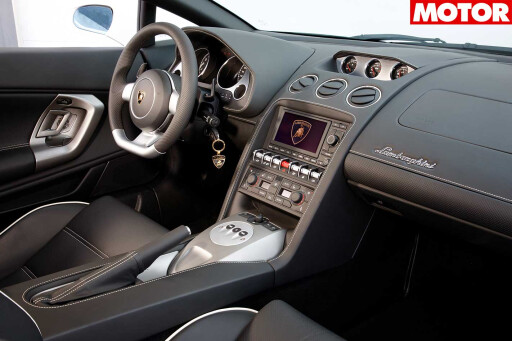 Space is still at a premium in the mid-engined two-seater, and this applies to the tight cabin as well as to the miniature boot. The Bauhaus body is not difficult to see out of, but headroom is scarce, and the driver-side footwell almost as cramped as a single-seat race car’s.
Space is still at a premium in the mid-engined two-seater, and this applies to the tight cabin as well as to the miniature boot. The Bauhaus body is not difficult to see out of, but headroom is scarce, and the driver-side footwell almost as cramped as a single-seat race car’s.
Vehicle control at the limit can be an issue when legs and arms collide. The soon-for-debut LP560-4 Spyder will be an even tighter fit, though its goose-pimple 10-tenths noise is bound to be even more radical.
You can put your money down on a Gallardo to show off; to make a blatant anti-Ferrari statement or to own the butchest car on the block. But there are much better buying motives than that, such as its fine handling and energetic roadholding, the magic V10 that slays most V8s for grunt and charisma, and the failsafe grip provided by all-wheel drive. You see, like the F430, the LP560-4 is a proper sports car, not a dressed up GT or an evolution of a relatively pedestrian base model.
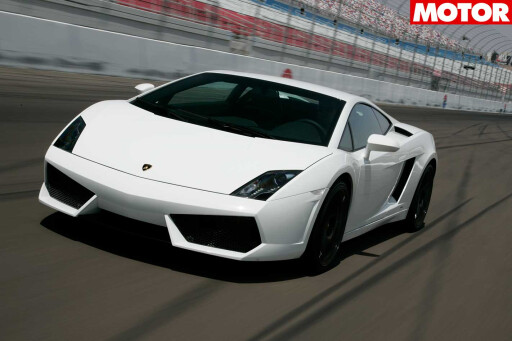 Although it is so good at being loud, brash and superficial, this bullish Lamborghini can actually challenge the leaders of the pack on the most demanding turf. It’s not only seriously fast, but in this latest and rather comprehensively-tweaked form, it is neatly balanced and beautifully accessible in the way it acts and responds. It achieves the fusion of classic showmanship and ability, of presence and agility, of extravagance and desirability.
Although it is so good at being loud, brash and superficial, this bullish Lamborghini can actually challenge the leaders of the pack on the most demanding turf. It’s not only seriously fast, but in this latest and rather comprehensively-tweaked form, it is neatly balanced and beautifully accessible in the way it acts and responds. It achieves the fusion of classic showmanship and ability, of presence and agility, of extravagance and desirability.
It is, in other words, a masterpiece.
WHAT'S IN A NAME?
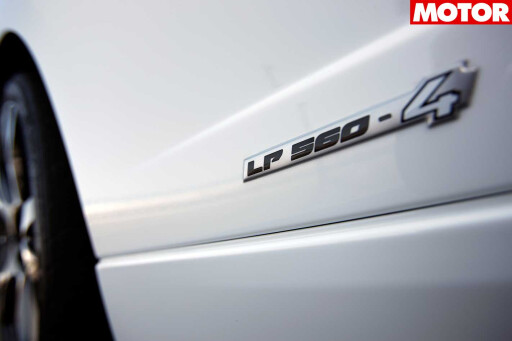 Time was you could rely on a Lamborghini to arrive with the most evocative names in the business. And, sometimes, the most difficult to pronounce. Lambo dealers the world over failed to reach consensus over such key nameplates as Countach, Murcielago and, surprisingly, even Gallardo. But what’s the story with LP560-4? Well, it follows on from the Murcielago’s LP640 designation and makes a valiant attempt at putting some logic into the naming process. The LP is the same acronym, standing for, in English, Longitudinal and, er, Posterior. That’s where the engine is and that’s which way it points. The rest is simple. Where the Murchey had 640 horsepower, the Gallardo has 560. The ‘4’ is simply four-wheel drive. - Michael Taylor
Time was you could rely on a Lamborghini to arrive with the most evocative names in the business. And, sometimes, the most difficult to pronounce. Lambo dealers the world over failed to reach consensus over such key nameplates as Countach, Murcielago and, surprisingly, even Gallardo. But what’s the story with LP560-4? Well, it follows on from the Murcielago’s LP640 designation and makes a valiant attempt at putting some logic into the naming process. The LP is the same acronym, standing for, in English, Longitudinal and, er, Posterior. That’s where the engine is and that’s which way it points. The rest is simple. Where the Murchey had 640 horsepower, the Gallardo has 560. The ‘4’ is simply four-wheel drive. - Michael Taylor
IT AIN'T ALL GOOD
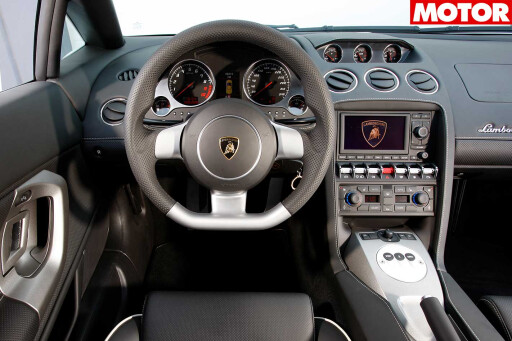 Even Lamborghini has accountants worming their way into the production process. Sadly, the LP560-4 has four disappointing areas of cost-cutting. First is the plastic, flat-bottom segment of the steering wheel. Maybe they’re trying to get you to buy the optional carbon-bottomed wheel, but it’s demeaning. Then there’s the two-piece plastic accelerator pedal with clip-on aluminium cover, replacing the old car’s seven-piece, all-metal affair. There’s also the chromed-plastic switch row, controlling everything from lights to windows. Finally, there’s the engine covers. Pop the see-through lid to show-off to the boys and you’ll be embarrassed when one of them taps the black engine covers. Yep, they’re plastic. - Michael Taylor
Even Lamborghini has accountants worming their way into the production process. Sadly, the LP560-4 has four disappointing areas of cost-cutting. First is the plastic, flat-bottom segment of the steering wheel. Maybe they’re trying to get you to buy the optional carbon-bottomed wheel, but it’s demeaning. Then there’s the two-piece plastic accelerator pedal with clip-on aluminium cover, replacing the old car’s seven-piece, all-metal affair. There’s also the chromed-plastic switch row, controlling everything from lights to windows. Finally, there’s the engine covers. Pop the see-through lid to show-off to the boys and you’ll be embarrassed when one of them taps the black engine covers. Yep, they’re plastic. - Michael Taylor
2008 Lamborghini Gallardo LP560-4
Body: 2-door, 2-seat coupe
Drive: all wheels
Engine: 90-degree V10, DOHC, 40v
Material: alloy head/alloy block
Bore/Stroke: 84.5 x 92.8mm
Capacity: 5204cc
Compression: 12.5:1
Power: 412kW @ 8000rpm
Torque: 540Nm @ 6500rpm
Redline/Cut: 8300/8300rpm
Fuel/Tank: 98 octane/90 litres
Kerb Weight: 1500kg
Power-to-Weight: 275kW/tonne
Transmission: 6-speed manual
Ratios: 3.31/2.05/1.45/1.13/0.93/0.74
Final Drive: 3.08
Suspension: double A-arms, coil springs, anti-roll bar (f); double A-arms, coil springs, anti-roll bar (r)
Length/Width/Height: 4345/1900/1165mm
Wheelbase: 2560mm
Tracks (f/r): 1632/1597mm
Steering: power rack and pinion
Turning circle: 11.5m
Lock-to-lock: 2.7 turns
Brakes: 365mm ventilated discs, eight-piston calipers (f); 356mm ventilated discs, four-piston calipers (r); ABS, EBD, ESP, ASR
Wheels: 19 x 8.5-inch (f), 19 x 11.0-inch (r), alloy
Tyres: Pirelli P Zero LRR 235/35ZR19 (f), 295/30ZR19 (r)
Price: $455,000 (estimated)
Fast Times
0-100km/h: 3.7sec (claimed)
Top speed: 325km/h (claimed)
Likes: Brilliant! – better than the Superleggera in every respect
Dislikes: Silly squared-off steering wheel; cramped interior
Rating: 9.5 out of 10 stars

COMMENTS